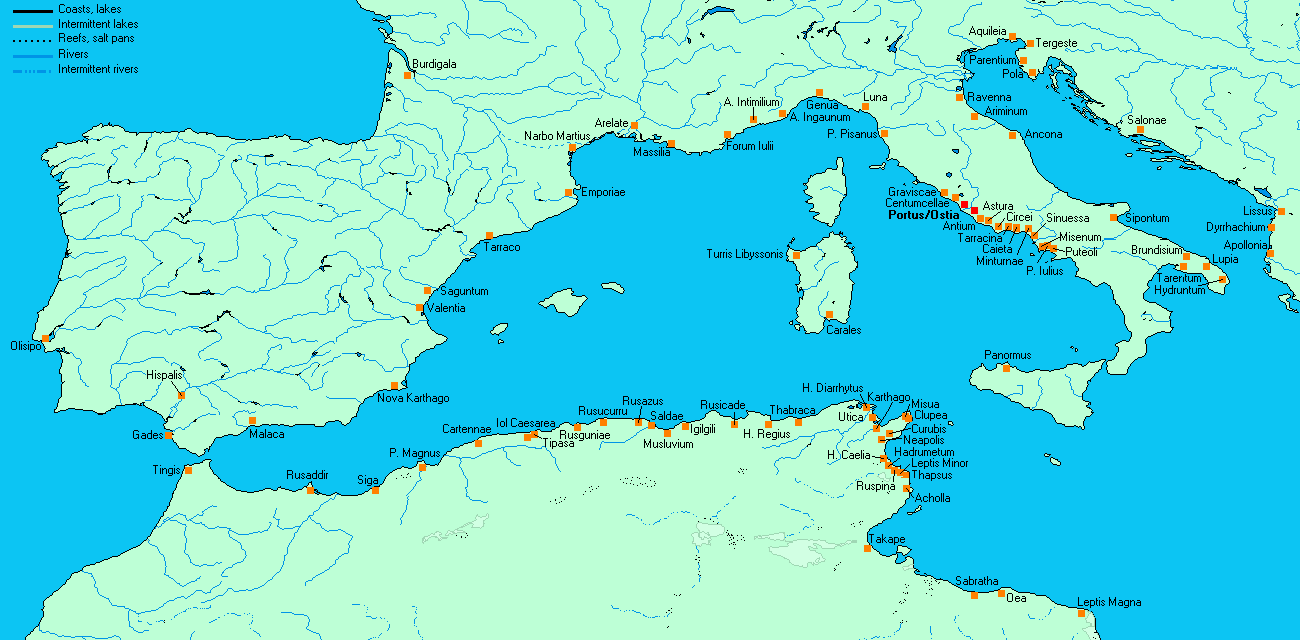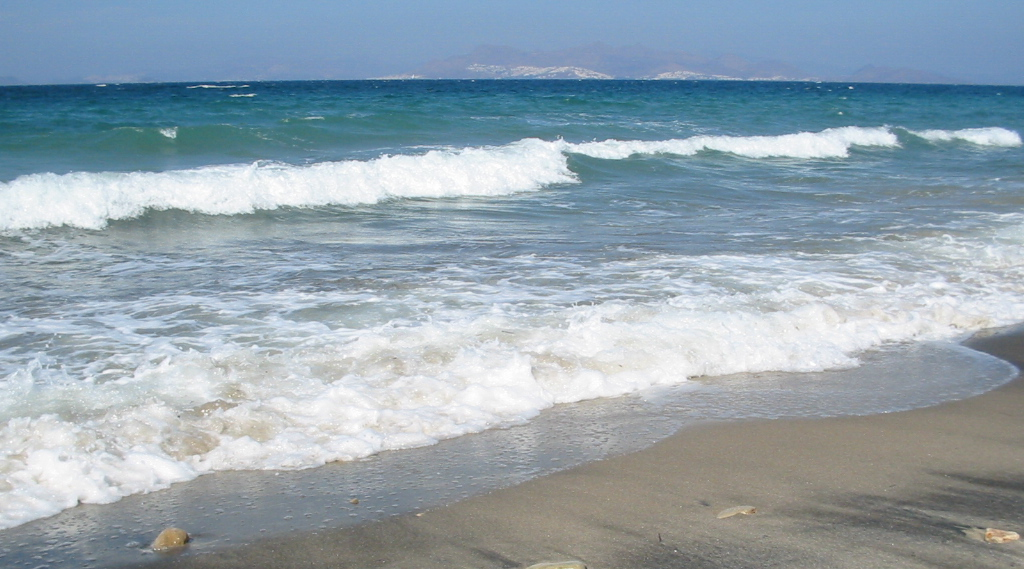Harbours and ports
Numerous harbours formed the starting point and end point of the traffic on the Mediterranean sea. A harbour is a protected area of water, natural or man-made. A port is a harbour plus terminal facilities: piers, wharves, docks, storage buildings, and an infrastructure of roads and rivers or canals. Therefore a harbour is merely a very important part of a port. The Romans used the same word for a harbour and a port: portus.
When studying harbours, two basic concepts are of great importance. "Hinterland" (originally a German word) is the area where traffic demand originates. It is connected to a port by means of inland communications: roads and rivers. The "Vorland" or foreland is made up of the seas accessed from the ports. Four types of hinterland can be distinguished: continental, semi-continental, regional, and local. In case of a continental hinterland, gaps or passes through mountain barriers are used to reach vast areas. An example of such a route is the Rhône valley. Spain is a semi-continental hinterland: it is large, but the Pyrenees block access to the rest of Europe. In Italy we find examples of the regional hinterland. It is a long, narrow peninsula, and no place is farther from the sea than 100 kilometers. Here a typical, regional hinterland could have a sea front of 60-80, and a depth of 100 kilometers. The local hinterland is served by small ports in river mouths or bays, which are visited by small boats coming from the regional ports. Things were different of course when military harbours were constructed, for example at Ravenna, Misenum and Carthago.

Some harbours in the western half of the Mediterranean Sea.
The various kinds of hinterland and the varying size of ships lead to ports of a different size. Long-distance traffic usually takes place only between the ports of a large hinterland. Here local distribution begins, and here a return cargo can be found. The ships that are active on these long-distance routes are of a considerable size, for several reasons. They need a supply of water and food, sleeping quarters, and so on. A long journey makes the transported goods more expensive and is economical only if the ship carries a large cargo. On the other hand, a very large cargo means a great loss in case of shipwreck. These large ships obviously need large harbours, with good facilities.
The ports of a local hinterland are visited only by ships engaging in local traffic. As the ports are small and shallow, the ships have a shallow draught. There is no space on these ships for large supplies of water and food, or for sleeping quarters. They must seek shelter in a harbour every night and stay near the coast. Such ships also sailed to the larger harbours, in order to load and unload.
Rivers were important gates to the hinterland. They emptied into the sea via deltas, which owed their existence to the absence of tides, and included swamps and lagoons. The swamps of the smaller rivers had already been drained in antiquity. They were then used for irrigated agriculture and cities were built here. Many of the new towns became harbour cities. Harbours or ports were not necessarily coastal cities however. Some lie behind the coast on lagoons, canals or rivers. Roman ships were often quite small, so that a good harbour was not necessarily big or deep. For many ships a depth of a few metres was sufficient. For the same reason lagoons were navigable. Narbo Martius (Narbonne) was 20 kilometres from the sea, but on a lagoon. Hispalis (Sevilla) was 86 kilometres inland up the river Guadalquivir.
The northern shore of the Mediterranean Sea is often steep, but contains many small natural harbours and landing places. The southern shore has very few natural harbours, and here artificial harbours had to be built. Generally speaking however, harbours could be built with relative ease on the Mediterranean Sea, because of the almost complete absence of tides. Things were different outside the Strait of Gibraltar, for example in Gades (Cádiz), at the mouth of the Guadalquivir: this was a tidal harbour. What did create a problem was the silt that the rivers took to the sea. It was carried along the coast by the mediterranean current - as we have seen in a counterclockwise direction. Harbours were therefore usually built at the "clockwise side" of the delta. The harbour of Alexandria for example was to the west of the Nile delta and therefore safe from the river silt. The Imperial harbours of Ostia on the other hand suffered from being to the north of the Tiber mouth: the counterclockwise current took silt to the harbours. During many centuries the coastline at the Tiber delta slowly moved seaward, and the harbours are now several kilometres inland. The winds were another factor influencing construction. Virtually all the best known ancient ports on the Tyrrhenian Sea shelter themselves from winds from the west and north.

A beach on the island of Kos. Photo: Jan Theo Bakker.
Often the construction of a harbour was a huge effort. The river port of Arelate (Arles) was, during the Republic, connected to the sea through channels, the Fossae Marianae. They made the Rhône delta navigable. The Romans sometimes used concrete that could set under water. Moles and breakwaters were constructed to provide protection against storms. Usually they were solid structures. Arched moles were built in the Bay of Naples during the early Empire. The idea behind the arches may have been that the water passing through them removed silt. The experiment was apparently not successful. In the second century moles without a connection to the land were built, possibly with the same purpose.
Very large ships required large harbours. The number of such harbours will have been restricted: most harbours were constructed for the smaller ships. Generally speaking the unloading of a ship of 150 tons will have taken two to four days. A cargo of 250 tons required six to eight days. Certain cargoes required special loading and unloading facilities. Sacks of grain and lighter amphorae could be carried by dockhands. Heavier amphorae were carried by two men, using poles slipped through the handles. Cranes were used for lifting heavy objects, such as marble sarcophagi and wild animals in cages. For the unloading of an obelisk, weighing many tons, exceptionally strong cranes must have been built.
Ostia and Portus became the main ports of Rome in the later first and second century AD. This was the result of the construction of artificial harbour basins by Claudius, Nero and Trajan; Ostia did not have a good, natural harbour. We must stress however that during Ostia's hey-day Rome was served by several ports. During the early Empire, Puteoli in the Bay of Naples was Rome's main harbour. From there goods were transported to Rome in small ships along the coast, and by road. Puteoli lost much of its importance after the construction of the artificial harbours at Ostia, but it remained a major port of Rome. To the south of Ostia a large harbour was built by Nero: Antium (Anzio-Nettuno). The building began right after the completion of work at Ostia. Two more harbours, each covering an area of some 100.000 square metres, were built by Trajan: Tarracina, to the south of Antium, and Centumcellae, sixty kilometres north of the Tiber.

|

|
| The Tiber in Rome, near the Tiber Island. Photo: Jan Theo Bakker. | A river god in the Capitoline museums. Photo: Jan Theo Bakker. |
Centumcellae (Civitavecchia) and Puteoli (Pozzuoli) are discussed as separate topics on this website. The final stage of the transport is dealt with in the section "From Ostia and Portus to Rome".